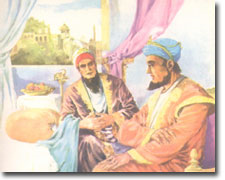DAROGA, from Persian daroghah, lit. “head man of an office, prefect of a town or village, overseer, or superintendent of any department,” is a term usually applied to a police officer in charge of a thana (police station) exercising jurisdication over a police circle. The title, equivalent of than adaror thanedar in the Punjab, is still used in some other Indian states to designate an inspector or subinspector of police in charge of a police station or, in official terminology, a station house officer, S.H.O. for short. During the medieval period, as even now, daroga, as a government official responsible for maintaining law and order in the countryside, enjoyed wide powers of detention and arrest. His counterpart, in larger towns, or superior was kotwal.
More Information:
The term “Daroga,” derived from the Persian word daroghah, historically referred to an overseer, superintendent, or head of an office. In Sikhism, the role of a Daroga was significant during the medieval period, particularly in administrative and law enforcement contexts. A Daroga was responsible for maintaining order and overseeing operations within a designated area, often exercising powers of detention and arrest. This position was akin to a police officer or inspector in charge of a jurisdiction.
In the Sikh tradition, Darogas were sometimes appointed to manage specific tasks or regions, ensuring the implementation of justice and governance in alignment with Sikh principles. Their role was not merely administrative but also symbolic of the Sikh commitment to fairness and accountability. For example, during the era of the Sikh Gurus and the Khalsa, individuals in such roles were expected to uphold the values of service (seva), humility, and justice.
The Daroga’s responsibilities extended to maintaining law and order in the countryside and larger towns, where their superior counterpart was often referred to as a Kotwal. This hierarchical structure ensured effective governance and the protection of the community’s interests.
The role of Darogas in Sikh governance was integral to maintaining law and order during the era of the Sikh Empire under Maharaja Ranjit Singh. Derived from the Persian word daroghah, meaning overseer or superintendent, Darogas were officials responsible for overseeing administrative and law enforcement functions within their designated jurisdictions. Their duties extended to ensuring justice, managing local governance, and maintaining peace in both rural and urban areas.
During the Sikh Empire, Darogas were tasked with implementing the Maharaja’s policies and directives, often serving as intermediaries between the central authority and local communities. They exercised powers of detention and arrest, ensuring compliance with the laws of the state. In larger towns, their superior counterpart was the Kotwal, who held broader responsibilities for urban governance.
The Darogas played a crucial role in upholding the principles of Sikh governance, which emphasized fairness, accountability, and service (seva). Their work was aligned with the Sikh ethos of protecting the vulnerable and ensuring justice for all, regardless of caste, creed, or social standing. This alignment with Sikh values distinguished their role from similar positions in other contemporary governance systems.





